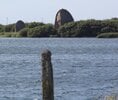The three concrete " listening ears" at Greatstone range in size from 20 to 200 feet in size. Built between 1928-30, the sound mirrors were part of Britain's national defence strategy. They were designed to pick up the sound of approaching enemy aircraft. Sound waves were caught in the belly of the mirror and relayed back through microphones and a stethoscope to an operator who raised the alarm. Anti-aircraft defences were then deployed. The mirrors effectively gave Britain a fifteen-minute warning of an impending attack.
The 20 feet(diameter) mirror was the first to be built in 1928. It was precast as one huge slab of curved concrete. Lessons were quickly learnt and a 30 feet(diameter) mirror, set at a different angle and providing greater accuracy, was built in early 1930 alongside the 20 foot mirror.
The 30ft mirror gave no advantage as to range but it was able to track an aircraft a lot more accurately than the 2oft mirro, which was only able to give estiamtions.
The third mirror is 200 feet in length and 26 feet high, and was built in 1930 alongside the other two smaller sound mirrors. Microphones were attached to the curved surfaces and in favourable conditions could pick up the sounds of aircraft up to 24 miles away.

The Sound Mirrors at Greatstone Lakes (ack.6)
The mirrors did work, and could effectively be used to detect slow moving enemy aircraft before they came into sight. They worked by concentrating sound waves towards a central point, where the microphone would have been located. (note the microphone in the picture of the 30 foot mirror below). However, their use was limited as aircraft became faster.
Operators also found it difficult to distinguish between aircraft and seagoing vessels. In any case, they quickly became obsolete due to the invention of radar in 1935, being finally abandoned in 1939.
The sound mirrors had a limited effectiveness, and the increasing speed of aircraft in the 1930s meant that they would already be too close to deal with by the time they had been detected. The development of radar put an end to further experimentation with the technique.
Nevertheless, there were long-lasting benefits. The sound mirror programme, led by Dr William Sansome Tucker, had given Britain the methodology to use interconnected stations to pinpoint the position of an enemy in the sky. The system they developed for linking the stations and plotting aircraft movements was given to the early radar team and contributed to their success in World War II; although the British radar was less sophisticated than the German system, the British system was used more successfully.
The Denge mirrors are situated on an island in the Dungeness Nature Reserve. The site is only accessible on open days when the RSPB provide a bridge to access to the mirrors. not to be beaten we bought a blow up boat and went over in that !!! visited with Stealth










The 20 feet(diameter) mirror was the first to be built in 1928. It was precast as one huge slab of curved concrete. Lessons were quickly learnt and a 30 feet(diameter) mirror, set at a different angle and providing greater accuracy, was built in early 1930 alongside the 20 foot mirror.
The 30ft mirror gave no advantage as to range but it was able to track an aircraft a lot more accurately than the 2oft mirro, which was only able to give estiamtions.
The third mirror is 200 feet in length and 26 feet high, and was built in 1930 alongside the other two smaller sound mirrors. Microphones were attached to the curved surfaces and in favourable conditions could pick up the sounds of aircraft up to 24 miles away.

The Sound Mirrors at Greatstone Lakes (ack.6)
The mirrors did work, and could effectively be used to detect slow moving enemy aircraft before they came into sight. They worked by concentrating sound waves towards a central point, where the microphone would have been located. (note the microphone in the picture of the 30 foot mirror below). However, their use was limited as aircraft became faster.
Operators also found it difficult to distinguish between aircraft and seagoing vessels. In any case, they quickly became obsolete due to the invention of radar in 1935, being finally abandoned in 1939.
The sound mirrors had a limited effectiveness, and the increasing speed of aircraft in the 1930s meant that they would already be too close to deal with by the time they had been detected. The development of radar put an end to further experimentation with the technique.
Nevertheless, there were long-lasting benefits. The sound mirror programme, led by Dr William Sansome Tucker, had given Britain the methodology to use interconnected stations to pinpoint the position of an enemy in the sky. The system they developed for linking the stations and plotting aircraft movements was given to the early radar team and contributed to their success in World War II; although the British radar was less sophisticated than the German system, the British system was used more successfully.
The Denge mirrors are situated on an island in the Dungeness Nature Reserve. The site is only accessible on open days when the RSPB provide a bridge to access to the mirrors. not to be beaten we bought a blow up boat and went over in that !!! visited with Stealth


